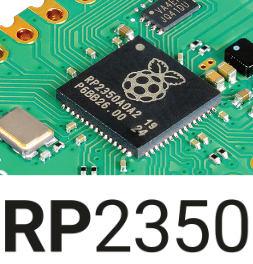
Raspberry Pi – RP2350 MCU & RP2354 SiP: With the RP2040 microcontroller, Raspberry Pi started to offer ICs developed in-house. The developers from Cambridge continued this with the RP1, a PCIe interface bridge that is used on the Raspberry Pi 5.
The new MCU RP2350 was introduced in 2024 and is now available in the A4 revision. In this new hardware revision, Raspberry Pi has fixed some errata discovered together with the community. Overall, the RP2350 is a significant upgrade to the RP2040 in many features.
The dual-core idea was continued in the RP2350 and the RP2354A/B SiP derivatives are the first controllers with integrated flash from Raspberry Pi to be available. For a quick start or easy integration into your application, the Raspberry Pi Pico 2 boards are available in the proven form factor.


